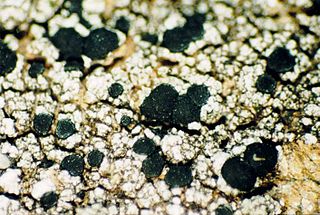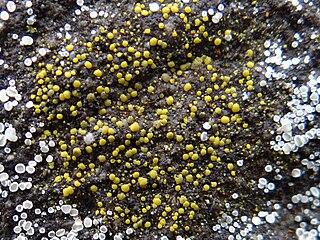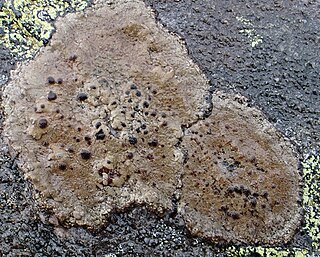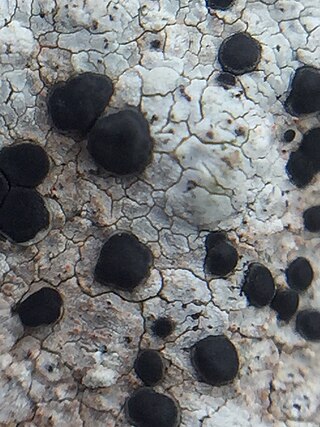
The Lecanoraceae are a family of lichenized fungi in the order Lecanorales. Species of this family have a widespread distribution.
Rimularia is a genus of lichenized fungi in the family Trapeliaceae. Rimularia was circumscribed by Finnish botanist William Nylander in 1868.

Pilophorus is a genus of lichen-forming fungi in the family Cladoniaceae. They are commonly known as matchstick lichens. The genus has a widespread distribution, especially in temperate regions, and contains 11 species. The genus was circumscribed by Theodor Magnus Fries in 1857, with Pilophorus robustus assigned as the type species.
Zwackhiomyces is a genus of lichenicolous fungi in the family Xanthopyreniaceae. The genus was circumscribed by Martin Grube and Josef Hafellner in 1990, with Zwackhiomyces coepulonus assigned as the type species.

Carbonea is a genus of fungi in the family Lecanoraceae. Most of the species grow on lichens. The genus is widespread, and contains 20 species. Carbonea was originally circumscribed as a subgenus of Lecidea in 1967 before it was promoted to generic status in 1983.

Lecidella is a genus of crustose lichens in the family Lecanoraceae.

Miriquidica is a genus of lichen in the family Lecanoraceae. The genus was circumscribed in 1987 by lichenologists Hannes Hertel and Gerhard Rambold, with Miriquidica complanata assigned as the type species. According to Dictionary of the Fungi, the widespread genus contains 23 species, found predominantly in arctic-alpine regions.

Protoblastenia is a genus of lichens in the family Psoraceae. It was originally circumscribed by Alexander Zahlbruckner in 1908 as a section of genus Blastenia. J. Steiner promoted it to generic status in 1911.

Fuscideaceae is a family of fungi that form symbiotic] relationships with algae to create lichens. These lichens typically have a crust-like appearance and are found worldwide, though they are most common in temperate regions. The family includes five genera and about 55 species, which primarily grow on tree bark, rocks, or occasionally on wood or leaves. Fuscideaceae lichens are characterised by their reproductive structures, cup-like formations called apothecia, which can vary in colour from red to dark brown or black. The family has undergone several changes in its classification over the years, with recent genetic studies placing it within the order Umbilicariales. Fuscideaceae lichens produce various chemical compounds, some of which are unique to this family, and these chemicals are often used to help identify different species.

The Lecideaceae are a family of lichen-forming fungi in the order Lecideales. It contains about 30 genera and roughly 250 species. A major distinguishing characteristic of the family is the lecanoroid form of the fruiting bodies: typically circular, dark, and without a thalline margin. Most species in the family are lichenised with green algae, although a few species, scattered amongst several genera, are lichenicolous—they live on other lichens. Lecideaceae lichens tend to grow on rocks, wood, and soil. Several Lecideaceae species accelerate the weathering of rock surfaces, a process known as pedogenesis, by extending their hyphae into cracks and expelling rock flakes. This contributes to significantly faster weathering rates in certain environments, impacts various materials from natural rocks to man-made Sekishu roof tiles, and involves key biomolecules identified for survival and biodeterioration, including compounds to withstand intense ultraviolet radiation.

Paraporpidia is a genus of lichen-forming fungi in the family Lecideaceae. It has three species of saxicolous (rock-dwelling) crustose lichens. The genus was circumscribed by Gerhard Rambold and M. Pietschmann in 1989, with Paraporpidia aboriginum assigned as the type species.
Poeltiaria is a genus of lichen-forming fungi in the family Lecideaceae. It was circumscribed in 1984 by lichenologist Hannes Hertel, with Poeltiaria turgescens assigned as the type species.

Porpidia is a genus of crustose lichens in the family Lecideaceae. Porpidia species primarily inhabit siliceous rocks, pebbles, and stonework, with rare occurrences on bark, wood, and compacted soil. The thallus, or body of the lichen, varies in appearance from thick and crusty to barely visible. It may form a continuous layer or develop cracks resulting in a segmented, areolate structure. The colour of the thallus ranges from grey and white to orange.

Fuscidea is a genus of crustose lichens in the family Fuscideaceae. It has about 40 species. The genus was circumscribed in 1972 by lichenologists Volkmar Wirth and Antonín Vězda, with Fuscidea aggregatilis assigned as the type species.

Nesolechia is a genus of parasitic fungi in the family Parmeliaceae. All three species in the genus grow on lichens. Nesolechia probably evolved from a lichen ancestor, as it is closely related to many lichenized species of fungi.

Phacopsis is a genus of lichenicolous (lichen-dwelling) fungi. They are parasites of members of the large lichen family Parmeliaceae, of which they are also a member. Originally proposed by Edmond Tulasne in 1852 to contain 3 species, Phacopsis now contains 10 species, although historically, 33 taxa have been described in the genus. Many of the species are poorly known, some of them having been documented only from the type specimen.

Protoparmelia is a genus of lichenized fungi in the family Parmeliaceae. The genus has a widespread distribution, and contains 11 species. Protoparmelia was circumscribed by French lichenologist Maurice Choisy in 1929.

Trapeliaceae is a family of lichens in the order Baeomycetales. The family contains 12 genera and about 125 species.

Schaereria is a genus of lichen-forming fungi. It is the sole genus in the family Schaereriaceae, which itself is the only family in the Schaereriales, an order in the subclass Ostropomycetidae of the class Lecanoromycetes. Most Schaereria species are crustose lichens that live on rocks. Schaereria was first proposed by Gustav Wilhelm Körber in 1855 and was later taken up by other lichenologists despite periods of disuse.
















